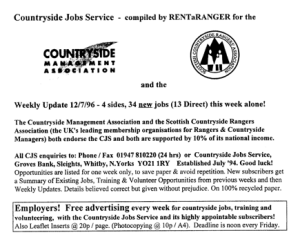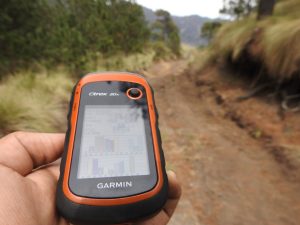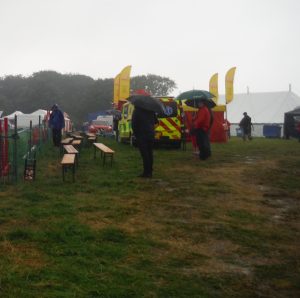From A4 to For All – 30 years of the Countryside Jobs Service
In July 1994 small envelopes started landing on the doormats of countryside rangers, inside were a couple of sheets of closely typed A4 containing details of vacancies in the countryside management sector. Since those small beginnings the Countryside Jobs Service has grown along with the green jobs sector. In 1994 solar power was restricted to a few houses whose roofs were strong enough to hold the large, very heavy panels that would help heat your house and wind turbines were those swinging wheels you saw in cowboy movies. It wasn’t long before Local Agenda 21 arrived bringing with it a host of sustainability initiatives designed to reduce waste, encourage reuse and introducing wide spread recycling. According to the Countryside Jobs Review 1996 CJS published 67 adverts for jobs working on LA21 projects.
containing details of vacancies in the countryside management sector. Since those small beginnings the Countryside Jobs Service has grown along with the green jobs sector. In 1994 solar power was restricted to a few houses whose roofs were strong enough to hold the large, very heavy panels that would help heat your house and wind turbines were those swinging wheels you saw in cowboy movies. It wasn’t long before Local Agenda 21 arrived bringing with it a host of sustainability initiatives designed to reduce waste, encourage reuse and introducing wide spread recycling. According to the Countryside Jobs Review 1996 CJS published 67 adverts for jobs working on LA21 projects.

Conservation was mainly for historic buildings and nature was the green stuff outside. The National Trust had wardens not rangers which meant we sometimes got enquiries about prison wardens! In 1996, the first year for which we have the data, we published 202 jobs for rangers and wardens, by 2023 that had risen to 1400 adverts (not vacancies) more than the total number of vacancies in 1996 (1008).
Which just shows how much things have changed. One thing remains the same though, ranger and countryside management are still the main stay for CJS. Ecology and biodiversity focused jobs now form the second largest group of vacancies with 957 adverts in 2023 (12% of all advertised online), however it wasn’t until 2010 that there were sufficient posts to warrant a separate category in the, what had become annual, Review with 155 vacancies comprising 6% of the total advertised that year.

Volunteers have always been a vital part of the conservation workforce but were mostly managed on an ad hoc basis by existing staff, dedicated volunteer co-ordinators and managers are a newer introduction. In 1998 the government introduced the New Deal, a workfare programme providing training, subsidised employment and voluntary work for the unemployed and brought with it the need for staff to manage this burgeoning cohort of volunteers and trainees some of whom had never set foot outside of a city park. CJS published the first adverts for New Deal Project Officers in February 1998 and by the end of the year had included 70 vacancies. Most organisations now have a member of staff with responsibility for recruiting, looking after and leading keen volunteer teams.

Pixabay
There are a few areas where things have not changed so much, Rights of Way and Access roles experienced a brief increase in response to the introduction of the CROW Act in 2000 as Definitive Maps were drawn up and finalised, however the introduction of technology such as GIS and GPS maps has in many ways made this specialist area less necessary for councils and agencies and numbers of jobs have plateaued.
Support staff are vital to keeping everything running smoothly and again this is an area which has grown with the sector, from a single secretary dealing with bookings and typing up minutes and letters when I first started at the National Park in 1996 to whole teams with some very specialised duties being recruited. In 2023 a Practice Manager was required to run the administration of an ecological consultancy, the recruit needed to have significant accountancy experience.
As the conservation sector is largely made up of charitable organisations sourcing funding has been part of many jobs, and along with publicity and promotional duties, was a major element in 374 adverts during 2023. Keeping up to date with the funding and grant sources has become almost a full time job and as major funders such as the Lottery go though their own evolutions it’s important that organisations are able to keep in touch and ensure they meet the new targets and criteria. Promotional roles have changed hugely since the first CJS edition when the internet was still in its infancy (I know can you believe it?) then it was all about writing press releases and setting up photo shoots for local (and sometimes national) newspapers – it’s still that but now sits as a smaller part of the job alongside running websites, blogs and trying to keep a handle on social media and the latest trends.

Something that was never even thought of 30 years ago was Diversity, Equality and Inclusion, this is a recent addition to subjects up for discussion, and we’ve carried a few articles about it and it is something that is beginning to be mentioned in job descriptions.
Education is I’m sure we can agree vital to ensuring the successful management of sites and also the understanding of the natural world around us and who better to impart this information than those actually working in this highly specialised sector for that reason CJS has always included jobs focusing on education and interpretation for all ages, which can involve anything from organising kite-making workshops and running teddy bear’s picnics for pre-schoolers to designing travelling pop-up displays promoting a site, project or the whole organisation at indoor and outdoor events. However I think most of us still think of teaching groups of school children on trips to the centre or site and this along with the newer forest school schemes is still the main bulk of work for Env Ed staff. But Education doesn’t stop with A levels and Year 13, there are specialist higher education courses for our budding countryside rangers and wildlife warriors and CJS includes these vacancies too as well as those offering and assessing CPD type courses. 
One very welcome change is the gradual awareness that volunteering is not sustainable for many people and we’re seeing many more paid traineeships and intern posts. These are really helping to grow the workforce and allowing our young people (and career changers too) to gain the all important experience and practical skills that are needed for a long, successful career in the sector and for too long were a missing element, one that many will know has frequently been a topic of discussion!
CJS’s growth has not only been in the range of jobs and careers but a widening in the content too, the website and newsletters now carry a wide variety of information, articles and in depth features aimed at the profession and giving a behind the scenes look at what life’s really like working in the sector, a full directory of training (long and short courses) and a daily news service – things that 30 years ago would never have fitted in those first little envelopes.

See what CJS has to offer today at www.countryside-jobs.com
